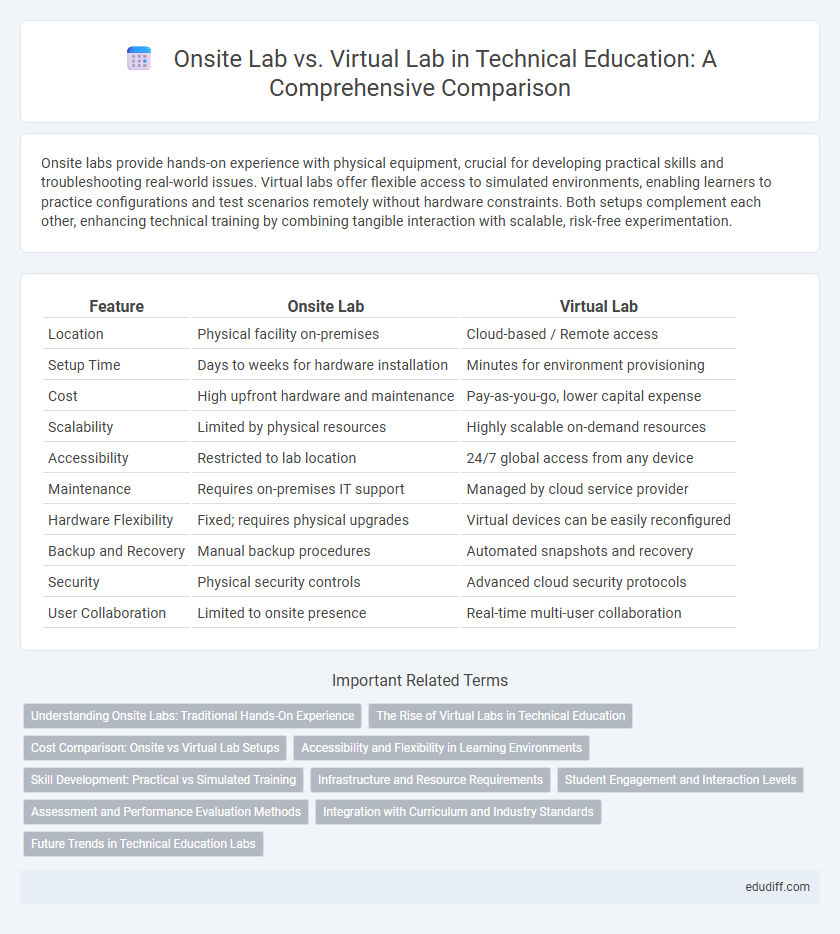Onsite labs provide hands-on experience with physical equipment, crucial for developing practical skills and troubleshooting real-world issues. Virtual labs offer flexible access to simulated environments, enabling learners to practice configurations and test scenarios remotely without hardware constraints. Both setups complement each other, enhancing technical training by combining tangible interaction with scalable, risk-free experimentation.
Table of Comparison
| Feature | Onsite Lab | Virtual Lab |
|---|---|---|
| Location | Physical facility on-premises | Cloud-based / Remote access |
| Setup Time | Days to weeks for hardware installation | Minutes for environment provisioning |
| Cost | High upfront hardware and maintenance | Pay-as-you-go, lower capital expense |
| Scalability | Limited by physical resources | Highly scalable on-demand resources |
| Accessibility | Restricted to lab location | 24/7 global access from any device |
| Maintenance | Requires on-premises IT support | Managed by cloud service provider |
| Hardware Flexibility | Fixed; requires physical upgrades | Virtual devices can be easily reconfigured |
| Backup and Recovery | Manual backup procedures | Automated snapshots and recovery |
| Security | Physical security controls | Advanced cloud security protocols |
| User Collaboration | Limited to onsite presence | Real-time multi-user collaboration |
Understanding Onsite Labs: Traditional Hands-On Experience
Onsite labs provide traditional hands-on experience by allowing direct interaction with physical equipment, fostering practical skills and real-time troubleshooting. They enable learners to manipulate hardware and observe immediate feedback, which enhances comprehension of complex technical concepts. This immersive environment supports collaborative learning and situational awareness critical for mastering intricate technological tasks.
The Rise of Virtual Labs in Technical Education
Virtual labs have revolutionized technical education by providing accessible, cost-effective, and scalable learning environments that simulate real-world experiments without physical constraints. Advanced cloud computing technologies and interactive software enable students to perform complex simulations and receive instant feedback, enhancing practical skills and theoretical understanding. The rise of virtual labs addresses limitations of onsite labs such as equipment costs, space, and safety concerns, making technical training more inclusive and adaptable to remote learning needs.
Cost Comparison: Onsite vs Virtual Lab Setups
Onsite lab setups involve significant upfront capital expenditure, including costs for physical space, hardware procurement, maintenance, and energy consumption, resulting in higher total cost of ownership. Virtual labs leverage cloud computing resources, offering scalable, pay-as-you-go pricing models that reduce capital investment and operational costs. Organizations benefit from virtual labs through minimized infrastructure expenses and enhanced flexibility, leading to more cost-effective training and development environments.
Accessibility and Flexibility in Learning Environments
Onsite labs provide direct access to specialized equipment and hands-on experience, essential for mastering physical tools and real-time troubleshooting. Virtual labs enhance flexibility by offering remote access to simulations and resources anytime, accommodating diverse schedules and geographic locations. Combining both approaches maximizes accessibility, allowing learners to choose environments that best suit their technical training needs and pace.
Skill Development: Practical vs Simulated Training
Onsite labs provide hands-on skill development through direct interaction with physical equipment, enabling learners to gain practical experience critical for mastering technical tasks. Virtual labs offer simulated training environments that replicate real-world scenarios, allowing for scalable, risk-free practice and the ability to repeat exercises for skill reinforcement. Combining both approaches maximizes competency by blending tactile learning with flexible digital simulation.
Infrastructure and Resource Requirements
Onsite labs demand substantial physical infrastructure, including dedicated space, hardware, and maintenance personnel, leading to higher upfront and operational costs. Virtual labs rely on cloud-based resources and virtual machines, enabling scalable and flexible access without the need for physical equipment or extensive onsite support. Resource allocation in virtual labs is optimized through virtualization technology, reducing downtime and increasing efficiency compared to the fixed capacity constraints of onsite environments.
Student Engagement and Interaction Levels
Onsite labs foster higher student engagement through direct, hands-on interaction with equipment, enabling immediate feedback and collaborative learning experiences. Virtual labs offer flexible access and simulation capabilities but may face challenges in replicating tactile involvement and spontaneous peer interaction. Optimizing student engagement requires balancing the immersive, kinetic experience of onsite labs with the accessibility and scalable interaction tools available in virtual environments.
Assessment and Performance Evaluation Methods
Onsite labs enable direct observation and hands-on assessment of technical skills, facilitating real-time performance evaluation through physical equipment interaction and immediate troubleshooting. Virtual labs utilize automated tracking and analytics tools that measure task completion times, error rates, and procedural accuracy within simulated environments, allowing scalable and consistent performance assessment. Combining data from both environments enhances the reliability of competency measurements by integrating tactile proficiency and digital task execution metrics.
Integration with Curriculum and Industry Standards
Onsite labs offer hands-on experiences aligned directly with curriculum objectives, enhancing students' practical skills through real-time interaction with physical equipment. Virtual labs integrate seamlessly with industry standards by providing adaptable simulations that reflect current technological advancements, ensuring students gain relevant competencies. This blend of experiential learning and up-to-date virtual scenarios supports comprehensive education tailored to evolving workforce demands.
Future Trends in Technical Education Labs
Onsite labs offer hands-on experience with physical equipment, essential for mastering complex technical skills, while virtual labs provide scalable, cost-effective simulations accessible anytime and anywhere. Future trends in technical education labs emphasize hybrid models integrating augmented reality (AR) and artificial intelligence (AI) to enhance interactive learning and remote collaboration. These innovations aim to bridge the gap between theoretical knowledge and practical application, preparing students for evolving industry demands.
Onsite Lab vs Virtual Lab Infographic

 edudiff.com
edudiff.com